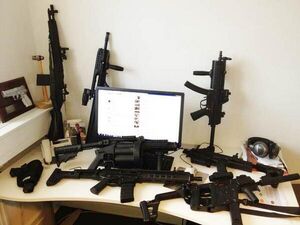AUG
| ||||||||||
Statistics
|
The AUG is an Austrian bullpup 5.56mm assault rifle, designed in the 1960s by Steyr Mannlicher GmbH & Co KG. The AUG (Armee-Universal-Gewehr) was adopted by the Austrian Army as the StG 77 (Sturmgewehr 77) in 1978, where it replaced the 7.62mm StG 58 automatic rifle. In production since 1978, it is the standard small arm of the Austrian Bundesheer and various national police units.
Features[]
The rifle features an Spz-kr type progressive trigger (pulling the trigger halfway produces semi-automatic fire, pulling the trigger all the way to the rear produces fully automatic fire) and a safety mechanism (cross-bolt, button type), located immediately above the hand grip. In its “safe” position (white dot) the trigger is mechanically disabled; pressing the safety button to the left exposes a red dot and indicates the weapon is ready to fire. Some versions have an ALO or "automatic lockout", a small projection at the base of the trigger. This was first included on the Irish Defence Forces variant of the rifle, and soon after, the Australian Defence Forces variant. In the exposed position the ALO stops the trigger being squeezed past the semi-automatic position. If needed, the ALO can be pushed up to permit automatic fire.
The rifle is fed from translucent, double-column box magazines (molded from a high-strength polymer) with a 30-round capacity and an empty weight of 130 g (4.6 oz). The light machine gun version of the AUG uses an extended 42-round magazine. An Argentine version of the FN FAL chambered in 5.56 mm NATO and known as the FALMP III Type 2 also used the AUG magazine.
Integrated with the receiver casting is a fixed carry handle that contains a 1.5x telescopic sight made by Swarovski Optik. It contains a simple black ring reticle with a basic rangefinder that is designed so that at 300 m (984.3 ft) a 180 cm (5.9 ft) tall man-size target will completely fill it, giving the shooter an accurate method of estimating range. The sight cannot be set to a specific range but can be adjusted for windage and elevation for an initial zero and is designed to be calibrated for 300 m. When so set, aiming at the centre of a target will produce a hit at all ranges out to 300 m. The rifle also has a back-up iron sight with a rear notch and front blade, cast into the top of the aluminium optical sight housing, used in case of failure or damage to the primary optical sight. The sight is also equipped with a set of three illuminated dots (one on the front blade and two at the rear) for use in low-level lighting conditions. In order to mount a wide range of optics and accessories, a receiver with a NATO-standard Picatinny rail and detachable carry handle was also developed and introduced in 1997.
Three-pronged, open-type flash suppressors were used on the 350 mm (13.8 in), 407 mm (16.0 in) and 508 mm (20.0 in) length barrels, whereas the 621 mm (24.4 in) light machine gun barrel received a closed-type ported muzzle device (combination flash suppressor and compensator) and an integral, lightweight folding bipod. The flash suppressors are screwed to the muzzle and internally threaded to take a blank-firing attachment.

Picture posted on The Division Twitter That shows the AUG behind the computer
The rifle comes standard with four magazines, a muzzle cap, spare bolt for left-handed shooters, blank-firing adaptor, cleaning kit, sling and either an American M7 or German KCB-77 M1 bayonet.The rifle features an Spz-kr type progressive trigger (pulling the trigger halfway produces semi-automatic fire, pulling the trigger all the way to the rear produces fully automatic fire) and a safety mechanism (cross-bolt, button type), located immediately above the hand grip. In its “safe” position (white dot) the trigger is mechanically disabled; pressing the safety button to the left exposes a red dot and indicates the weapon is ready to fire. Some versions have an ALO or "automatic lockout", a small projection at the base of the trigger. This was first included on the Irish Defence Forces variant of the rifle, and soon after, the Australian Defence Forces variant. In the exposed position the ALO stops the trigger being squeezed past the semi-automatic position. If needed, the ALO can be pushed up to permit automatic fire. The rifle is fed from translucent, double-column box magazines (molded from a high-strength polymer) with a 30-round capacity and an empty weight of 130 g (4.6 oz). The light machine gun version of the AUG uses an extended 42-round magazine. An Argentine version of the FN FAL chambered in 5.56 mm NATO and known as the FALMP III Type 2 also used the AUG magazine.
Integrated with the receiver casting is a fixed carry handle that contains a 1.5x telescopic sight made by Swarovski Optik. It contains a simple black ring reticle with a basic rangefinder that is designed so that at 300 m (984.3 ft) a 180 cm (5.9 ft) tall man-size target will completely fill it, giving the shooter an accurate method of estimating range. The sight cannot be set to a specific range but can be adjusted for windage and elevation for an initial zero and is designed to be calibrated for 300 m. When so set, aiming at the centre of a target will produce a hit at all ranges out to 300 m. The rifle also has a back-up iron sight with a rear notch and front blade, cast into the top of the aluminium optical sight housing, used in case of failure or damage to the primary optical sight. The sight is also equipped with a set of three illuminated dots (one on the front blade and two at the rear) for use in low-level lighting conditions. In order to mount a wide range of optics and accessories, a receiver with a NATO-standard Picatinny rail and detachable carry handle was also developed and introduced in 1997.
Three-pronged, open-type flash suppressors were used on the 350 mm (13.8 in), 407 mm (16.0 in) and 508 mm (20.0 in) length barrels, whereas the 621 mm (24.4 in) light machine gun barrel received a closed-type ported muzzle device (combination flash suppressor and compensator) and an integral, lightweight folding bipod. The flash suppressors are screwed to the muzzle and internally threaded to take a blank-firing attachment.
The rifle comes standard with four magazines, a muzzle cap, spare bolt for left-handed shooters, blank-firing adaptor, cleaning kit, sling and either an American M7 or German KCB-77 M1 bayonet.


